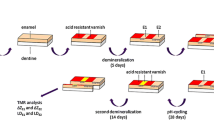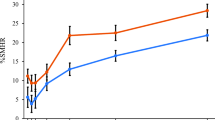Abstract
The effect of fluoride released by bioadhesive tablets was evaluated in an in situ model in human volunteers. Eight volunteers carried four to six polished human enamel samples in a lower lingual device for a period of 5 days without fluoride supplements (control) and 5 days using one bioadhesive tablet (0.5 mg F) per day, placed in the lower buccal sulcus. Changes in mineral content were measured in terms of surface microhardness indentation length (load 0.98 N, Knoop diamond indenter). Some enamel samples were analyzed for their fluoride content by means of a surface etch biopsy. The indentation length increased significantly in both experiments, but demineralization was less pronounced with fluoride (indentation length increased from 44±7 to 48±13 µm) than in the control (44±7 to 58±13 µm). The fluoride concentration and the amount of calcium in the acid etch biopsy specimens of the enamel samples did not differ significantly between the two groups. Bioadhesive, fluoride-releasing tablets have therefore demonstrated the potential to reduce demineralization by elevating salivary and plaque fluoride concentration for a period of several hours. This self-administered device can be a supplementary means for prevention of caries.
Similar content being viewed by others
Author information
Authors and Affiliations
Additional information
Received: 2 February 2000 / Accepted: 2 May 2000
Rights and permissions
About this article
Cite this article
Bottenberg, P., Cleymaet, R., Röhrkasten, K. et al. Microhardness changes in surface enamel after application of bioadhesive fluoride tablets in situ. Clinical Oral Investigations 4, 153–156 (2000). https://doi.org/10.1007/s007840000076
Issue Date:
DOI: https://doi.org/10.1007/s007840000076




